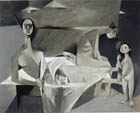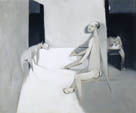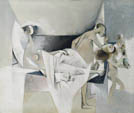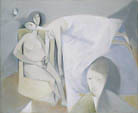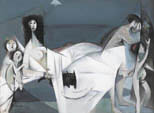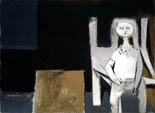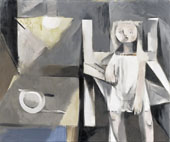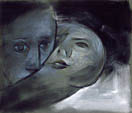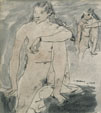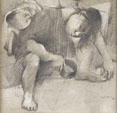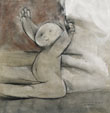The artist embarks on the 'Grey Period' Family paintings (c.1951-54), the third distinctive period in the
artist's work. According to John Russell: 'In the early 1950's, above all,
he came before us as a man who was looking for the image that would compound
all other images. Anyone who was around at the time and concerned with
what was called "post-war British art" will remember the painting
called "A Family" (1951; National Gallery, Ireland).'91 Widely
acknowledged as the artist's masterpiece from the period, the painting
marks a shift in palette from the comparatively colourful work of the late
forties to predominant whites and greys. John Berger writes in Art News
and Review: 'His style has developed and changed; his colours are pale
and severe - the Family is mostly grey; his forms, in their movement
both across and into the picture, are precise. This finesse implies - because
le Brocquy's motive is always human - a tenderness which is not sentimental,
and a sense of wonder which is exact; one thinks twice about the quite
ordinary but in fact miraculous construction of any man's back, having
looked at the father in the Family. Le Brocquy is completely free
of contemporary tendency to cosmic megalomania. It has become pretentious
to talk of an artist's humility, yet that is what distinguishes his work;
his studies testify to his patience, and his final, large picture to his
refusal to evade simple but difficult problems by relying on the grandiose
cliché'. Dr. Síghle Bhreathnach-Lynch notes of this large
composition: 'An oil on canvas, almost two metres wide the picture depicts
a family group ... The mother, lying on a table, leaning on one arm, stares
out with quiet dignity while a menacing looking cat peers out from beneath
the drawn sheet. In the background the father sits, head bowed, in a pose
suggesting total dejection. He appears to be oblivious to the small child
holding a bunch of flowers; a symbol of hope. The three sombrely painted
figures inhabit a grey concrete bunker, lit by a bare bulb. The theme of
this disturbingly bleak work is the nature of individual isolation and
the breakdown of societal norms.' |
